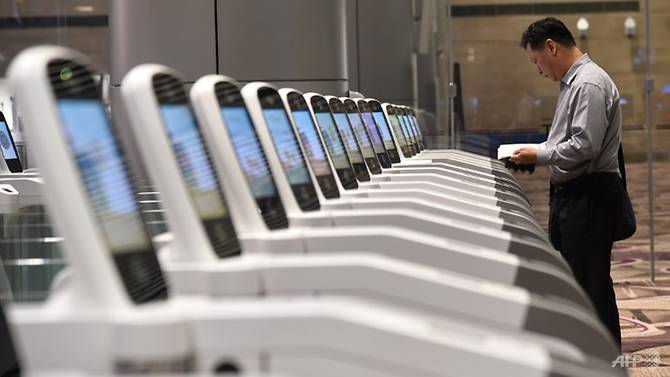Wider Causeway just one step KL is mulling over to ease congestion

A file picture taken on Dec 22, 2018, showing the traffic jam at the Causeway. Malaysia is considering measures to ease the congestion, including expanding the link and creating a shipping lane. ST FILE PHOTO
Malaysia is considering a slew of measures to ease congestion at the Causeway, including expanding the link, building a covered walkway and creating a shipping lane, it said yesterday.
A special committee chaired by Prime Minister Mahathir Mohamad had met for the first time on Wednesday to discuss ways to resolve the long-standing traffic problem at the two links connecting Malaysia's Johor state with Singapore - the Causeway in Woodlands as well as the Second Link in Tuas.
Travellers now take between 40 minutes and two hours to clear the 1.06km-long Causeway during peak hours. More than 300,000 people use the Causeway daily.
According to a statement by the Home Ministry yesterday, initiatives considered include increasing funding for the two entry points, forming a single border agency to oversee all the country's borders and entry points including ports, and conducting a study to identify issues and challenges in planning for future capacity needs.
Deputy Home Minister Mohd Azis Jamman announced last month the proposal to form a single agency to coordinate operations at the two entry points, to boost efficiency and reduce congestion.
He said it was necessary to create a single agency as there are 23 government agencies from various ministries stationed at the Customs and Immigration Checkpoint at Bangunan Sultan Iskandar and 13 agencies at Kompleks Sultan Abu Bakar Checkpoint, both in Johor.
These include offices of the immigration, Customs, road transport and health departments, the police and the highway operator.
The meeting on Wednesday agreed to set up a sub-committee comprising several ministers and representatives of the Johor state government, to be chaired by the Home Minister, to follow up on initiatives and fine-tune them.
A spokesman said there was a need for such an infrastructure after the state government found out that many people risked their lives by crossing the Causeway on foot.
The proposals include widening and extending the Causeway, building a covered pedestrian walkway, setting up a shipping lane and expanding existing entry points.
Earlier this year, the Johor government said it was looking to build a 1.2km walkway on the Causeway at an estimated cost of RM15 million (S$5 million).
Johor Public Works, Infrastructure and Transportation Committee chairman Mohd Solihan Badri had said the idea was mooted after the state government found that many people risked their lives walking across the link without proper facilities to ensure their safety.
Commuters often walk across the Causeway during peak hours to avoid being stuck in traffic. Many of them spill over into vehicle lanes before continuing their journey on public transport upon reaching Singapore, he added. The footpath will be built on existing motorcycle lanes on both sides of the Causeway.
The Home Ministry did not elaborate on how a shipping lane would ease congestion, although a similar proposal had cropped up in 2003, when Tun Dr Mahathir mooted the idea of an S-shaped highway to replace the Malaysian side of the Causeway that would allow vessels to pass underneath. The so-called crooked bridge plan was dropped by then Prime Minister Abdullah Badawi when he took over from Dr Mahathir in 2003.
~Straits Times~
CAAS chief sets sights on faster airport clearance

If the technology is proven reliable, a smart digital tower, utilising cameras along Changi Airport's runways as well as artificial intelligence, could eventually replace physical control towers.PHOTO: ST FILE
By 2024, air travellers should be able to arrive at the airport 85 minutes before their flight - a 30 per cent improvement from the current average of two hours.
That is the target set for the aviation community by Civil Aviation Authority of Singapore director-general Kevin Shum, who urged the industry to improve and simplify processes on Thursday (Aug 15).
He noted that while Changi Airport and the supporting aviation industry have been making "good progress" towards the goal of adopting technology to improve productivity, incremental change will not be enough going forward due to the demands in an increasingly globalised and digital environment.
"If we operate on a business-as-usual basis, we will need to hire and train 6,000 more skilled workers over the next decade. This will be very difficult given the shortage of manpower in Singapore," said Mr Shum.
Adding that he is optimistic the target can be achieved without compromising on service standards and while adopting sustainable practices for the environment, Mr Shum said achieving the goal would require "fundamental shifts" in terminal operations, airside activities as well as air traffic management.
"It will be something that can only be done by the whole community working together - regulators and policymakers, airport operator, airlines, immigration officers, ground-handlers, air traffic controllers," said Mr Shum, speaking at the launch of the Aviation Open House at Suntec Singapore Convention & Exhibition Centre.
The aviation authority also aims to make one in four jobs senior-friendly by 2030, said Mr Shum. To do this, senior workers will have to embrace changes and technology to upgrade their skills, and this would enable them to have longer and more meaningful careers, he added.
Mr Sunny Yang, Changi Airport Group's associate general manager of airside management, demonstrating the new simulator on trial that uses virtual reality for training Passenger Loading Bridge operators.
Some of the technological developments that would help to achieve this goal are on display at the biennial Aviation Open House, such as the smart digital control tower prototype that will go on trial later this year.
If the technology is proven reliable, the smart digital tower, which utilises cameras along Changi Airport's runways as well as artificial intelligence, could eventually replace physical control towers.
Other innovations on display include a speech recognition prototype that will automate and shorten the transcription process during an aviation incident investigation, developed by Mitre Asia Pacific Singapore, as well as an experimental project by European plane-maker Airbus to develop unmanned air delivery of parcels.
Visitors will also be able to interact with aviation industry representatives who will share their career experiences and provide advice to students and job seekers who are considering a career or education in the industry.
Interactive workshops will also be held, including two classes under the Airbus Foundation Little Engineer Programme that will see participants assembling their own A380 airplane model.
The Aviation Open House will be held from Aug 15 to 17 at the Suntec convention centre. Admission is free. Those who pre-register for the event will receive a free goodie bag.
More information is available at www.aviationopenhouse2019.sg
~Straits Times~
Proceed with JB-Singapore Rapid Transit System, Malaysian govt urged
After delaying the Johor Baru-Singapore Rapid Transit System (RTS) five times, a group now wants the government to proceed with the project without further ado.
The RTS Monitoring Group said the project was important for the cross-border movement of people with an estimated 250,000 to 300,000 commuters using the Johor-Singapore Causeway daily.
Its representative Dr Tee Ching Seng (pic) said the Pakatan Harapan government had delayed the project five times since it took over the country's administration, compromising the interest of the people.
"The deadline for the (suspension of the) project (with Singapore) is Sept 30. If this beneficial project ends up getting cancelled, the government will have to compensate Singapore S$67 million.
"As it is, RM1.8mil (S$596,330) has already been paid to Singapore due to the delay. We urge the government to carry on with the RTS project.
"The people count in this project, which can effectively resolve the traffic congestion at the Causeway and improve quality of life, especially for those who have to commute daily," he said here yesterday.
The agreement for the RTS project, which covers 4km of rail between Bukit Chagar, Johor Baru and Woodlands, Singapore, was signed between Malaysia and Singapore on Jan 16 last year and slated for completion by Dec 31, 2024.
However, in May, Prime Minister Tun Dr Mahathir Mohamad said that a six-month study would be carried out on the project to determine if this was indeed beneficial.
On May 21, Malaysia and Singapore signed a supplemental agreement to suspend the project until Sept 30.
~Asia One~
Electronic arrival card trial extended to more visitors to Singapore

More visitors to Singapore will be able to submit electronic arrival cards as the Immigration and Checkpoints Authority (ICA) launches the beta version of its SG Arrival Card e-service on Wednesday (Aug 14).
The service, available on ICA’s website and as a mobile application, allows visitors travelling via selected transport operators to submit electronic arrival cards up to 14 days before they arrive in Singapore.
The transport operators included in this trial are: AirAsia, Jetstar Asia, Cathay Pacific, Singapore Airlines, Transtar Travel, BatamFast Ferries, Bintan Resort Ferries, Horizon Fast Ferry and Majestic Fast Ferry.
Visitors travelling on these transport operators and who submit the electronic arrival cards before arriving in Singapore will only need to produce their passports for immigration clearance, without having to fill in the paper arrival cards.
“Users of the mobile application will have the option of scanning their passport biodata pages, and enjoy the convenience of not needing to manually key in the information,” ICA said in a news release.
“The mobile application will also save previously submitted information for use on subsequent trips to Singapore.”
Foreign visitors who arrive in Singapore without completing the physical disembarkation/embarkation cards were allowed to submit an electronic arrival card at the checkpoint under a trial conducted by ICA since October last year.
Singaporeans, permanent residents and long-term pass holders were not included in the trial.
Electronic arrival cards will completely replace the paper versions by 2021. “ICA will study the results of this trial and progressively extend the SG Arrival Card facility to foreign visitors,” the authority said, adding that more details will be announced at a later date.

Screengrab of the SG Arrival Card mobile app. (Image: ICA)
In April, ICA announced that foreign travellers will no longer have their passports stamped when departing Singapore, as a way to streamline processes and speed up immigration clearance.
Travellers who enrol their fingerprints in the BioScreen system upon arrival are eligible to use automated lanes when they leave Singapore.
Source: CNA/ga(cy)
Singapore may experience haze in coming weeks and months: Met Service
There may be occasional haze in the next few weeks or months as drier conditions are expected, said the Meteorological Service Singapore on Friday (Aug 2).
Drier-than-normal weather conditions have been forecast in the coming weeks for Singapore and the surrounding region, including Sumatra and Kalimantan.
"In recent days, persistent hotspot activities with smoke plumes have been observed in Riau and Jambi provinces in Sumatra and southern parts of Kalimantan," said the Met Service.
"These conditions can lead to an escalation of hotspot activities and an increase in the risk of transboundary haze occurrence in Singapore and the surrounding region."
The number of hot spots from forest fires in Indonesia has been increasing, prompting authorities to declare an emergency in six provinces on the island of Sumatra and the province of Kalimantan.
Thousands of military and police have been deployed to douse the forest fires.
Singapore has also been experiencing dry and warm weather in recent weeks.
The Met Service said on Thursday that last month was the driest July since rainfall records began in 1869. It was also the second warmest since temperature records began in 1929.
The Met Service said it will continue to closely monitor the regional weather and haze situation.
"The likelihood of haze affecting Singapore is dependent on factors such as the proximity and extent of the fires, the direction and strength of the prevailing winds, and the incidence of rain," it said, adding that information on the haze can be found on its website.
Source: CNA/ec(gs)




